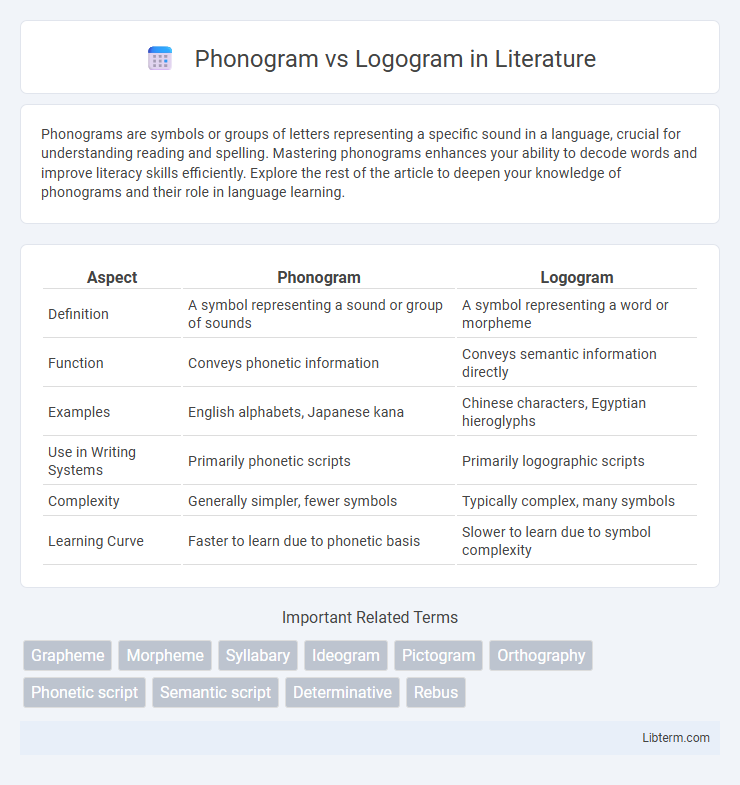Phonograms are symbols or groups of letters representing a specific sound in a language, crucial for understanding reading and spelling. Mastering phonograms enhances your ability to decode words and improve literacy skills efficiently. Explore the rest of the article to deepen your knowledge of phonograms and their role in language learning.
Table of Comparison
| Aspect | Phonogram | Logogram |
|---|---|---|
| Definition | A symbol representing a sound or group of sounds | A symbol representing a word or morpheme |
| Function | Conveys phonetic information | Conveys semantic information directly |
| Examples | English alphabets, Japanese kana | Chinese characters, Egyptian hieroglyphs |
| Use in Writing Systems | Primarily phonetic scripts | Primarily logographic scripts |
| Complexity | Generally simpler, fewer symbols | Typically complex, many symbols |
| Learning Curve | Faster to learn due to phonetic basis | Slower to learn due to symbol complexity |
Introduction to Phonograms and Logograms
Phonograms represent sounds or phonetic components and are fundamental in alphabets like Latin and Cyrillic, whereas logograms symbolize entire words or morphemes, as seen in Chinese characters and Egyptian hieroglyphs. Phonograms enable the construction of words through sound combinations, facilitating language learning and literacy across diverse languages. Logograms convey meaning directly through symbols, often preserving historical or cultural context embedded in their visual form.
Defining Phonograms: Sounds in Writing
Phonograms represent sounds in writing, encoding individual phonemes or syllables to form words, making them fundamental in phonetic alphabets like Latin and Cyrillic. Unlike logograms, which symbolize entire words or concepts such as Chinese characters, phonograms enable readers to decode language by sounding out symbols. This sound-based system supports the construction of diverse vocabularies using a limited set of symbols, enhancing literacy and communication efficiency.
What are Logograms? Symbols as Words
Logograms are graphic symbols that represent entire words or morphemes rather than individual sounds, making them fundamental components of writing systems like Chinese characters and ancient Egyptian hieroglyphs. Unlike phonograms, which denote phonetic sounds or syllables, logograms convey meaning directly, allowing readers to understand the intended word or concept without sounding it out. This symbolic approach enables efficient communication by visually representing complex ideas through singular symbols, streamlining reading and interpretation in logographic languages.
Historical Development of Writing Systems
Phonograms represent sounds and formed the basis of early alphabetic scripts, evolving from ancient Egyptian hieroglyphs around 3000 BCE, which combined phonetic and ideographic elements. Logograms, exemplified by Sumerian cuneiform and Chinese characters, convey entire words or morphemes, originating in Mesopotamia circa 3200 BCE and gradually refined for administrative and literary purposes. The transition from logographic to phonographic systems marked a significant historical development, enabling more flexible and widely accessible written communication.
Key Differences Between Phonograms and Logograms
Phonograms represent sounds or syllables, linking written symbols directly to pronunciation, whereas logograms symbolize entire words or morphemes without indicating specific sounds. Phonograms are foundational in alphabets and phonetic scripts, enabling flexible word construction, while logograms provide a direct semantic meaning often seen in systems like Chinese characters. The key difference lies in phonograms encoding phonetic information, contrasted with logograms encoding meaning independently of pronunciation.
Advantages and Disadvantages of Each System
Phonograms represent sounds and enable flexible word formation, facilitating literacy and language learning but may cause ambiguity due to homophones. Logograms symbolize entire words or concepts, allowing quick recognition and efficient communication in languages with complex morphology but require extensive memorization and can be difficult for new learners. Each system reflects a trade-off between ease of use and cognitive load, impacting literacy rates and language preservation.
Examples of Phonogram-Based Languages
Phonogram-based languages use symbols that represent sounds, such as alphabets or syllabaries, enabling the construction of words through sound units. Examples include the Latin alphabet used in English and many European languages, the Japanese kana syllabaries (hiragana and katakana), and the Korean Hangul script. These phonetic systems contrast with logogram-based languages like Chinese, where each character represents a word or morpheme rather than individual sounds.
Examples of Logogram-Based Languages
Logogram-based languages use symbols that represent entire words or morphemes, such as Chinese characters, which convey meaning without spelling out sounds explicitly. Other notable examples include Egyptian hieroglyphs and Sumerian cuneiform, both of which rely on logograms combined with phonetic elements. These writing systems differ fundamentally from phonograms, which represent individual sounds or syllables, exemplified by alphabetic scripts like English.
Influence on Literacy and Language Learning
Phonograms represent sounds and enable learners to decode words phonetically, enhancing literacy by promoting sound-letter correspondence and improving reading fluency. Logograms symbolize entire words or morphemes, often requiring memorization of individual characters, which can lead to slower acquisition but deeper recognition of language meaning and structure. The choice between phonogram and logogram systems significantly influences reading strategies, with phonograms supporting phonics-based learning and logograms favoring visual memory and context-based comprehension.
Future Trends in Writing Systems
Phonograms, representing sounds, and logograms, symbolizing words or morphemes, are evolving with the integration of artificial intelligence and augmented reality, enabling dynamic and context-sensitive writing systems. Future trends indicate a shift towards hybrid systems combining phonetic precision with logographic efficiency to enhance communication speed and machine interpretability. Emerging technologies are driving the development of multimodal writing tools that blend traditional scripts with interactive digital elements, transforming literacy and information exchange worldwide.
Phonogram Infographic

 libterm.com
libterm.com